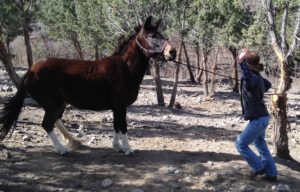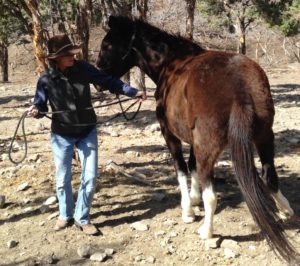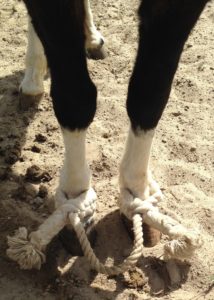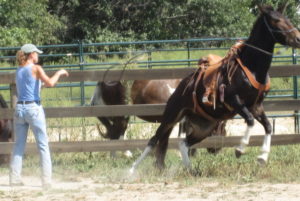Scatterbrained horsemanship like mine has a way of leaving holes in training.
That’s ok, I tell myself. Exposed holes get filled and the return to fundamentals makes for an improved horse, an improved rider, and, most importantly, an improved relationship. Read about filling Holes in Training.
Over our 18-month history, Jolene has gotten away from me dozens of times. She has this history of spooking and bolting on the ground (Oddly, she doesn’t have as many issues when I’m on board.)
A friend reaches out to pat her.
Gone.
I sneeze.
Gone.
Sudden burst of wind.
Gone.
Recently, I introduced some exercises to encourage Jolene to have more tenacity or “staying power.”
The power of a snub
 To snub is to check the movement of a horse by wrapping the lead line around a post or a tree. A nervous horse who pulls back when its line is around a post will still be able to move, but she won’t get away. It’s a preferable alternative to tying a horse fast and hard or having the horse get loose.
To snub is to check the movement of a horse by wrapping the lead line around a post or a tree. A nervous horse who pulls back when its line is around a post will still be able to move, but she won’t get away. It’s a preferable alternative to tying a horse fast and hard or having the horse get loose.
For some time, I had treated Jolene like the sensitive mule she is. I’d move slowly and introduce new objects, new spaces with delicacy. It was time to move on, or as my friend, Kim Stone, related years ago: “If you treat a horse like a glass doll, it will break!”
Now, I had a new plan. After bringing her from the pasture, I find a decent space with a tree and move her with vigor and  animation. At first, she tries to bolt, especially when I’m in her right eye. Each time, I act nutty until she pauses. At that moment, I stop.
animation. At first, she tries to bolt, especially when I’m in her right eye. Each time, I act nutty until she pauses. At that moment, I stop.
I switch sides and repeat. Jolene is learning that she can move her feet without leaving me and that I won’t restrict her.
After she’s relaxed with this snubbing exercise, I transition to moving her animatedly without the tree to help me. (see photo at right) She’s finding staying power in a sensible manner.
Another strategy – hobbles
Hobbles are a great way to prepare your horse for any scary situation of leg  restriction – caught in wire, tangled in rope, bound by ground vines, etc. As clinician Craig Cameron explains in this video, “if they’re not hobble-trained, they will panic and get hurt.”
restriction – caught in wire, tangled in rope, bound by ground vines, etc. As clinician Craig Cameron explains in this video, “if they’re not hobble-trained, they will panic and get hurt.”
Rick Gore has a great page dedicated to hobbles and hobble training. Click here.
I introduced Jolene gently, with soft, cotton hobbles (not leather or nylon).
Maybe it was too gentle. With her narrow stance and these lengthy hobbles (see right), she was able to step almost normally. Nonetheless, she learned there was no need to panic with something restrictive around her legs. When I approached her with hands up, she moved her haunches over once, then stood still.
Progress!
Read Amy Skinner’s checklist for first rides.
Read about progress in strange places.
Read about filling Holes in Training.

